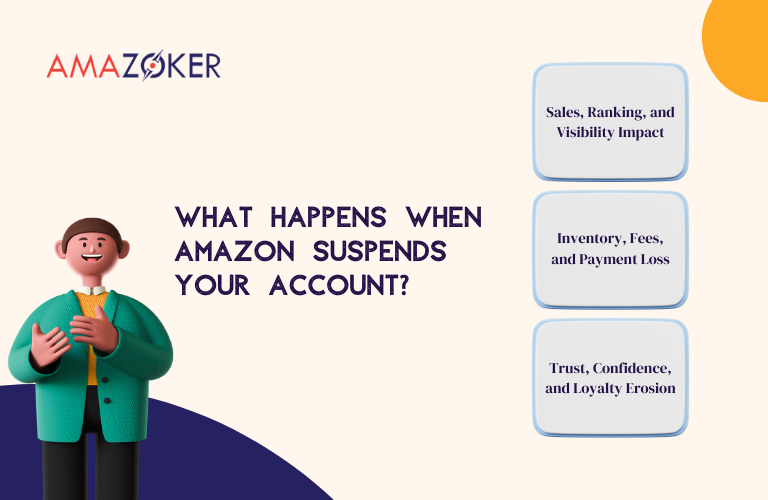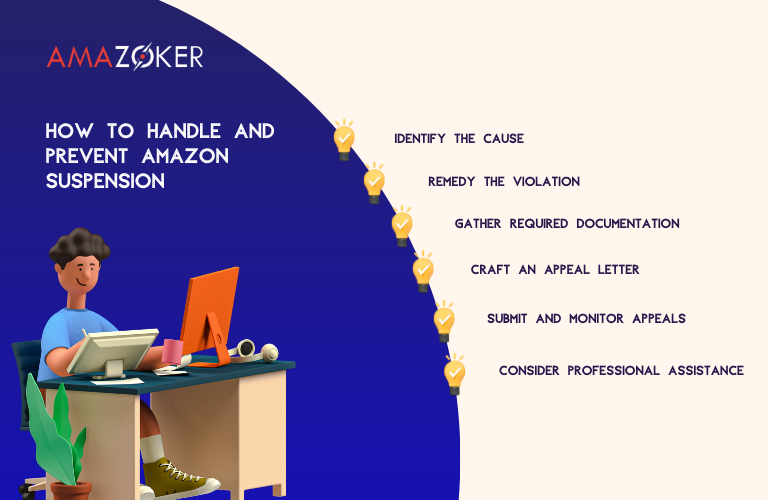Being an Amazon seller, there are instances where unintentional breaches or deliberate violations of Amazon’s policies or performance standards occur. These missteps could lead to the suspension or termination of your account or product listings. For any seller, an Amazon suspension or termination is a distressing blow, potentially causing substantial loss in revenue, tarnishing your reputation, and driving away customers. That’s why it’s crucial to grasp the most common reasons for amazon suspension, comprehend why Amazon suspended seller account, and learn how to effectively manage, mitigate, and prevent such occurrences.
Table of Contents
- Most 15 Common Reasons for Amazon Suspension
- Policy Violations
- Inauthentic Items
- Poor Performance Metrics
- Intellectual Property Infringement
- Late Shipment or Order Defect Rate
- Product Quality Issues
- Multiple Accounts
- Misuse of Product Reviews
- Seller Performance Issues
- Listing Issues
- Selling Restricted Items
- Account Verification
- Policy Non-Compliance
- Payment Issues
- Suspicious Activity
- What Happens When Amazon Suspends Your Account?
- How to Handle and Prevent Amazon Suspension
- Amazoker Recovery Service
Most 15 Common Reasons for Amazon Suspension
According to Amazon, there are more than 50 reasons for amazon account suspension, but some of the most common ones are:
Policy Violations
These breaches involve contravening Amazon’s established guidelines for sales on their platform. Examples include selling counterfeit, prohibited, or restricted items, engaging in dropshipping arbitrage, or infringing on intellectual property rights.
Inauthentic Items
This refers to selling products that aren’t genuine, original, or authorized by the manufacturer or brand owner. This can include fake, refurbished, or gray market products.
Poor Performance Metrics
Failing to meet Amazon’s expectations for customer service, order fulfillment, or product quality. This might involve high rates of order defects, late shipments, cancellations, or refunds.
Intellectual Property Infringement
Infringing on others’ intellectual property rights, like trademarks, copyrights, patents, or trade secrets. This could include unauthorized use of brand names, logos, images, or designs.
Late Shipment or Order Defect Rate
Failure to ship orders promptly or delivering defective products, impacting the customer experience by shipping after the expected date or providing damaged or misrepresented items.
Product Quality Issues
Products that don’t meet Amazon’s standards for quality, safety, or authenticity, such as defective, expired, counterfeit, or mislabeled items.
Multiple Accounts
Creating or using more than one seller account without Amazon’s approval, often done to sell the same products, manipulate reviews, or alter search results.
Misuse of Product Reviews
Manipulating the review system by posting fake reviews, deleting negative ones, or incentivizing positive feedback, compromising the integrity of customer feedback.
Seller Performance Issues
Failing to maintain or enhance seller performance metrics like order defect rate, cancellation rate, late shipment rate, valid tracking rate, customer service response time, feedback, and reviews.
Listing Issues
Not adhering to Amazon’s rules for creating and maintaining product listings, including inaccurate or incomplete information, prohibited content, or misleading details.
Selling Restricted Items
Listing or selling products requiring approval or authorization from Amazon or brand owners, such as those in gated categories or specific brands.
Account Verification
Failure to verify account information or identity with Amazon, necessary for security and authenticity. This includes providing invalid or outdated personal or financial information.
Policy Non-Compliance
Failure to comply with Amazon’s policies intended to safeguard the rights of Amazon, sellers, and buyers, like Selling Policies, Seller Code of Conduct, Product Detail Page Rules, Anti-Counterfeiting Policy, or Customer Product Reviews Policies.
Payment Issues
Not paying fees to Amazon or not receiving payments, impacting cash flow and profitability, which could involve not paying selling or referral fees or not receiving sales proceeds or reimbursements.
Suspicious Activity
Engaging in fraudulent activity that poses a risk to Amazon, sellers, or buyers, such as hacking, phishing, identity theft, money laundering, or tax evasion.

When Amazon suspends account, it implies a temporary block of account or products
What Happens When Amazon Suspends Your Account?
When Amazon suspends your account, it implies a temporary block or removal of your account or products from their platform. Consequently, you lose the ability to list or sell products, manage inventory or orders, access tools and reports, or receive any payments through Amazon.
Amazon suspension can have various consequences, such as:
- Sales, Ranking, and Visibility Impact: Suspension of your account or products results in a loss of sales, ranking, and product visibility. This detrimentally impacts your income, reputation, and customer base. Moreover, it relinquishes your competitive advantage, allowing other sellers with similar products to gain market share.
- Inventory, Fees, and Payment Loss: Account or product suspension can lead to the loss of inventory, fees, and associated payments. This includes potential forfeiture of stored inventory in Amazon’s fulfillment centers, incurring fees or charges due to the suspension, and non-receipt of payments for sales, refunds, or reimbursements.
- Trust, Confidence, and Loyalty Erosion: Account or product suspension risks the erosion of trust, confidence, and loyalty from customers, suppliers, or partners. Such actions may raise doubts regarding your credibility, reliability, or product quality. Additionally, you may encounter negative feedback, reviews, or claims from dissatisfied customers due to service disruptions or product dissatisfaction.
How to Handle and Prevent Amazon Suspension
If you want to handle and prevent Amazon suspension, you need to follow these steps:
- Identify the Cause: Understand the reason why Amazon suspends accounts by reviewing the notification from Amazon. Acknowledge any mistakes made and offer an apology for the violation.
- Remedy the Violation: Act swiftly to rectify the issue and implement measures to prevent its recurrence. Present evidence of compliance and improvements made.
- Gather Required Documentation: Obtain and submit necessary documents (e.g., invoices, certificates) to verify product authenticity or supplier legitimacy as per Amazon’s requirements.
- Craft an Appeal Letter: Follow Amazon’s prescribed format: Introduction, Action Plan, and Conclusion. Ensure clarity, concise language, proper grammar, and a well-structured layout using bullet points or paragraphs.
- Submit and Monitor Appeals: Send your appeal letter and supporting documents via Seller Central or the Report Infringement Form. Track the appeal’s progress, promptly respond to Amazon’s inquiries, and provide additional information if requested.
- Consider Professional Assistance: If navigating the process is daunting or if confidence is lacking, consider employing an appeal service like Amazoker’s. These services offer expertise in crafting persuasive appeals, liaising with Amazon’s seller performance team, and persisting until your account or products are reinstated.

Steps needed to handle Amazon suspension.
Amazoker Recovery Service
Amazoker stands out as an exemplary and highly trustworthy Amazon appeal service, renowned for its consistent reliability. With a track record of assisting numerous sellers, this service has earned its reputation through successful resolutions of various Amazon-related issues. Its impressive success rate is accompanied by a commitment to providing comprehensive, complimentary consultations.
Moreover, Amazoker offers a unique benefit of multiple appeal attempts at no extra cost until a favorable outcome is achieved. Their pricing structure is fair and transparent, ensuring accessibility for sellers seeking assistance. Beyond appeal services, Amazoker extends its expertise to additional areas such as Amazon ungating, LLC registration, and trademark registration, diversifying its support for e-commerce businesses.

Amazoker is an exemplary and highly trustworthy appeal service.
In conclusion, understanding the most common reasons for Amazon suspension is a crucial step for any seller looking to establish and maintain a thriving presence on the platform. As we’ve explored the various factors that can lead to suspension, it’s evident that vigilance, adherence to Amazon’s policies, and proactive measures are indispensable.
Read more:











